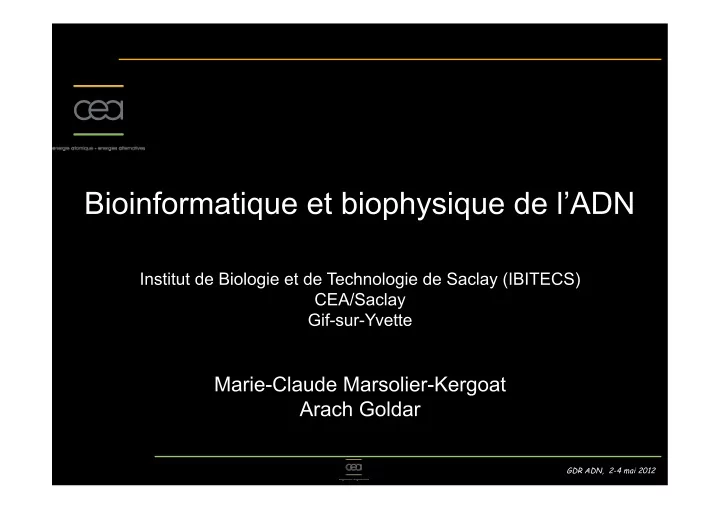

GDR ADN, 2-4 mai 2012
Replication in eukaryotic genomes Specific features of eukaryotic replication: - multiple replication origins - large variability in the timing of activation and in the efficiency of a given origin O1 O2 3’ 5’ 3’ 5’ lagging segment leading segment GDR ADN, 2-4 mai 2012
DNA replication in eukaryotes X. laevis S. cerevisiae S. pombe (4) 2.1 S. pombe (5) H. sapiens H. sapiens 's chromosome VI D. melanogaster' s chromosome 2L theoretical model D. melanogaster' s 2009 1.4 ) -1 I(t') (kb 0.7 0.0 0.0 0.3 0.6 0.9 t' In eukaryotes the rate of origin activation (I(t)) increases as S phase begins, after some time decreases and reaches zero at the end of S phase. Goldar, A. , Labit, H., Marheineke, K., and Hyrien, O. 2008. A dynamic stochastic model for DNA replication initiation in early embryos. PLoS One 3(8): e2919 Goldar, A., Marsolier-Kergoat, M.C. , and Hyrien, O. 2009. Universal temporal profile of replication origin activation in eukaryotes. PLoS One 4(6): e5899 GDR ADN, 2-4 mai 2012
DNA replication in eukaryotes The rate of origin activation and the density of replication forks are correlated. Guilbaud G, Rappailles A, Baker A, Chen CL, Arneodo A, Goldar, A. , d'Aubenton-Carafa Y, Thermes C, Audit B, Hyrien O. Evidence for sequential and increasing activation of replication origins along replication timing gradients in the human genome. PLoS Comput Biol. 2011 Dec;7(12):e1002322 Ma E, Hyrien O, Goldar A . Do replication forks control late origin firing in Saccharomyces cerevisiae? Nucleic Acids Res. 2012 Mar 1;40(5):2010-9 GDR ADN, 2-4 mai 2012
How the initiation rate is regulated? Model: Is the rate of origine activation regulated by : • intra-S checkpoint ? • chromatin remodeling factors ? • cell-cycle proteins ? GDR ADN, 2-4 mai 2012
Home-developed methods Software and methods to analyze quantitatively combing images Software and methods to analyze quantitatively Facs data GDR ADN, 2-4 mai 2012
The intrastrand parity rules Under no-strand-bias conditions, i.e. in the absence of selective or mutational differences between the two complementary strands of DNA, the composition of a single DNA strand at equilibrium should be such that : C = G and A = T. (Lobry, 1995 ; Sueoka, 1995) Leading and lagging strands may have different substitution rates, which can result in different GC and TA skews (defined as (G-C)/(G+C) and (T-A)/(T+A)). Replication-related compositional biases had been demonstrated in eubacteria and in some parts of the human genome, but the generality of their existence in eukaryotic genomes remained unclear. GDR ADN, 2-4 mai 2012
Replication-related compositional skews in yeast Ori1 Ori2 3’ 5’ 3’ 5’ fork convergence point 5’ 3’ leading segment lagging segment GC or TA skew (G-C)/(G+C) (T-A)/(T+A) Ori1 Ori2 Replication origins are marked by skew jumps, as their location is fixed. Termination sites may also be associated with skew jumps, but not necessarily as the position of the fork convergence point may vary, depending on the relative firing times of the adjacent origins. Due to the stochasticity of origin firing in eukaryotes, a given sequence is sometimes replicated as a leading strand and sometimes as a lagging strand, in contrast to what is observed in prokaryotic genomes. GDR ADN, 2-4 mai 2012
Replication-related compositional skews in yeast Consequently, replication-related compositional biases in yeast were demonstrated by pooling together the sequences of all intergenic intervals. S. cerevisiae K. lactis ( G - C )/( G + C ) (%) ( G - C )/( G + C ) (%) Ori1 Ori2 Ori1 Ori2 Fractional interorigin position leading lagging C-rich and A-rich G-rich and T-rich Marsolier-Kergoat, M.-C. and Goldar, A. (2012). DNA replication induces compositional biases in yeast. Mol. Biol. Evol. 29:893-904. GDR ADN, 2-4 mai 2012
Expertises : - Analyses biophysiques de l’ADN (peignage moléculaire) - Analyse des séquences d’ADN - Modélisation Intérêt pour le GDR : - Source de collaborations et d’échanges dans les domaines des 3R et de la modélisation GDR ADN, 2-4 mai 2012
Thank you for your attention GDR ADN, 2-4 mai 2012
Recommend
More recommend